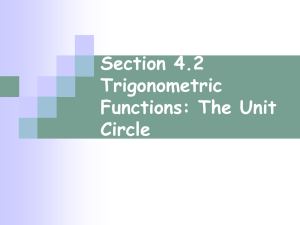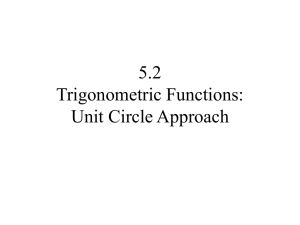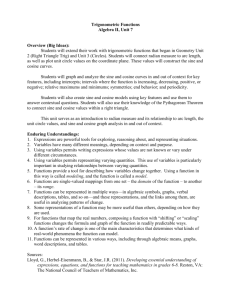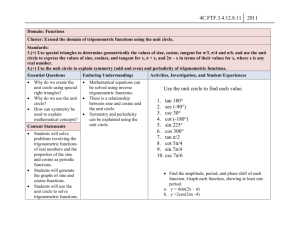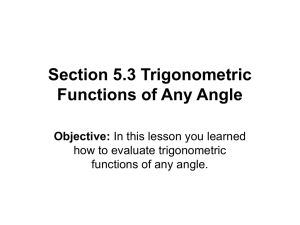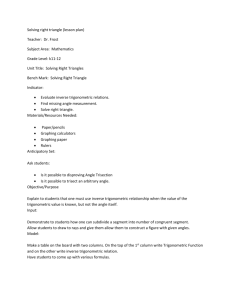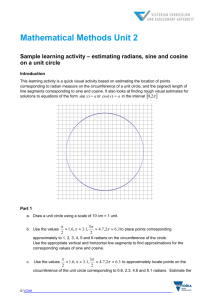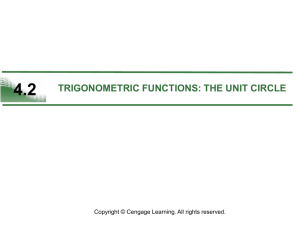Advanced Math I
advertisement
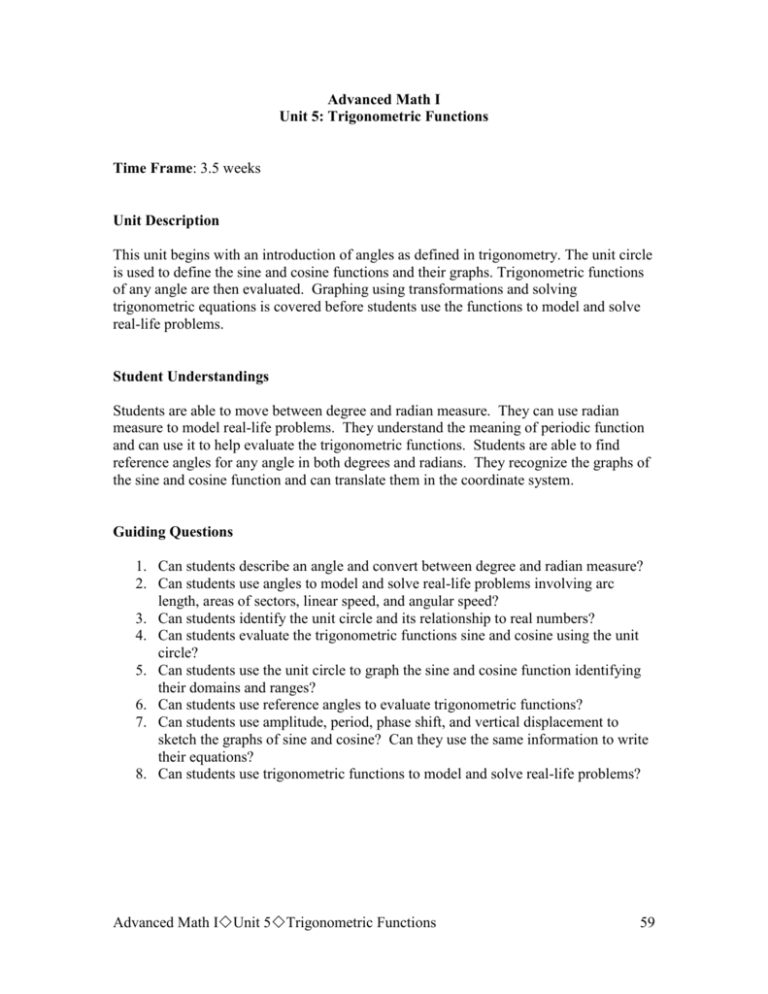
Advanced Math I Unit 5: Trigonometric Functions Time Frame: 3.5 weeks Unit Description This unit begins with an introduction of angles as defined in trigonometry. The unit circle is used to define the sine and cosine functions and their graphs. Trigonometric functions of any angle are then evaluated. Graphing using transformations and solving trigonometric equations is covered before students use the functions to model and solve real-life problems. Student Understandings Students are able to move between degree and radian measure. They can use radian measure to model real-life problems. They understand the meaning of periodic function and can use it to help evaluate the trigonometric functions. Students are able to find reference angles for any angle in both degrees and radians. They recognize the graphs of the sine and cosine function and can translate them in the coordinate system. Guiding Questions 1. Can students describe an angle and convert between degree and radian measure? 2. Can students use angles to model and solve real-life problems involving arc length, areas of sectors, linear speed, and angular speed? 3. Can students identify the unit circle and its relationship to real numbers? 4. Can students evaluate the trigonometric functions sine and cosine using the unit circle? 5. Can students use the unit circle to graph the sine and cosine function identifying their domains and ranges? 6. Can students use reference angles to evaluate trigonometric functions? 7. Can students use amplitude, period, phase shift, and vertical displacement to sketch the graphs of sine and cosine? Can they use the same information to write their equations? 8. Can students use trigonometric functions to model and solve real-life problems? Advanced Math IUnit 5Trigonometric Functions 59 Unit 5 Grade-Level Expectations (GLEs) GLE # GLE Text and Benchmarks Algebra 4. Translate and show the relationships among non-linear graphs, related tables of values, and algebraic symbolic representations (A-1-H) GLE # GLE Text and Benchmarks 6. Analyze functions based on zeros, asymptotes, and local and global characteristics for the function (A-3-H) 8. Categorize non-linear graphs and their equations as quadratic, cubic, exponential, logarithmic, step function, rational, trigonometric, or absolute value (A-3-H) (P-5-H) Measurement 11 Calculate angle measures in degrees, minutes, and seconds (M-1-H) 12 Explain the unit circle basis for radian measure and show its relationship to degree measure of angles (M-1-H) 13 Identify and apply the unit circle definition to trigonometric functions and use this definition to solve real-life problems Patterns, Relations, and Functions 24 Model a given set of real-life data with a non-linear function (P-1-H) (P-5-H) 25 Apply the concept of a function and function notation to represent and evaluate functions (P-1-H) (P-5-H) 28 Represent and solve problems involving the translation of functions in the coordinate plane (P-4-H) Sample Activities Ongoing: Glossary notebook Words to add: radian, initial side of an angle, terminal side of an angle, positive angles, negative angles, coterminal angles, reference angles, central angles, arc, linear speed, angular speed, unit circle, periodic functions, fundamental period, amplitude, phase shift. Activity 1: Sectors, Arcs, Linear and Angular Velocity (GLEs: 11,12) Prior to this activity introduce students to radian measure. They should be proficient in converting between degree and radian measure. This activity gives students practice in using radian measure. The problems involving sectors and arcs review the concepts of central angles and the arcs they intercept while introducing the idea of radian measure of an arc. Students learn to calculate the linear and angular velocities of one or more rotating objects. They learn that the angular velocity of a point on a rotating object is the number of degrees, radians, or revolutions per unit time through which the point turns while the linear velocity of that point is the distance per unit time that the point travels on its circular path. Advanced Math IUnit 5Trigonometric Functions 60 Part I: Writing activity: Explain the steps needed to convert an angle from degree measure to radian measure. Part II: Group activity: Have students use angles to model and solve real-life problems involving arc length, areas of sectors, linear speed, and angular speed. Give students a handout of problems such as the ones below. 1. The diagram to the right shows part of a Norman arch. Find the volume of stone in the arch. 2. The diagram to the right shows a sector AOB of a circle with a 15 cm radius and a center at O. The angle θ at the center of the circle is 115o. a. Calculate the area of the sector AOB. b. Calculate the area of the shaded region. 3. The diagram to the right shows a circle with center O and a radius of 15 cm. The arc ACB subtends a central angle of 2 radians. a. Find the length of the arc ACB. b. Find the area of the shaded region. Advanced Math IUnit 5Trigonometric Functions 61 4. The small pulley in the diagram to the right has a radius of 3 cm and is turning at 120 rpm. It is connected by a belt to the larger pulley that has a radius of 8 cm. a. Find the angular velocity of the small pulley in radians per second. b. Find the linear velocity of the rim of the small pulley. c. How many rpm is the larger pulley turning? d. Find the angular velocity of the larger pulley in radians per second. e. What is the linear velocity of the rim of the large pulley? Error! Solutions for Activity 1: 1. ≈0.094 m3 2. a) ≈ 225.8 cm2 b) ≈ 123.8 cm2 3. a) 30 cm b) ≈ 481.86 cm2 4. a) 4π radians/sec b) ≈ 37.70 cm/sec c) the small pulley makes 8 revolutions to the larger pulleys 3revolutions so the larger pulley is turning at 45 rpm d) the angular velocity is 1.5π radians/sec e) 37.70 cm/sec Activity 2: Computing the Values of Trigonometric Functions of General Angles (GLEs: 11, 12) The trigonometric ratios were introduced in Geometry and reviewed in Unit 4 of this course. Students also reviewed the 30 -60 and the 45 -45 right triangles. In this activity students will find exact values of the trigonometric functions for general angles use coterminal angles to find the exact value of a trigonometric function be able to determine the sign of a trigonometric function in a given quadrant find the reference angle of a general angle find the exact value of a trigonometric function of an angle given one of the ratios and the quadrant in which the angle is located Problems: 1. In the problems below a point on the terminal side of an angle θ is given. Find the exact value of each of the six trigonometric functions. a) (4, 3) b) (-3, -3) c) (-1, 0) 2. In the problems below name the quadrant in which the angle θ lies. a) sin θ < 0, tan θ > 0 b) cos θ > 0, csc θ < 0 c) cos θ < 0, cot θ < 0 3. Find the exact value of each expression. Do not use a calculator. a) tan 405 b) sin 390 c) cot (-60 ) d) csc(-315 ) e) cos 780 Advanced Math IUnit 5Trigonometric Functions 62 f) sec (-390 ) 4. Find the reference angle for each of the following: 3 8 7 a) b) c) d) 490 4 3 4 e) -260 5. Find the exact value of each of the remaining trigonometric functions of θ 12 4 a) sin , in quadrant II b) cos , in quadrant III 13 5 Solutions for Activity 2: 1. sinθ cos θ tan θ sec θ csc θ cot θ a 3/5 4/5 ¾ 5/4 5/3 4/3 b 1 2 2 2 2 1 2 2 c 0 -1 0 -1 undefined undefined 2. a) quadrant III 3. a) 1 4. a) b) ½ 4 b) 3 b) quadrant IV 3 c) d) 2 3 c) 4 d) 50 c) quadrant II 2 3 e) ½ f) 3 e) 80 5. sinθ cos θ tan θ sec θ csc θ cot θ a 12/13 -5/13 -12/5 -13/5 13/12 -5/12 b -3/5 -4/5 ¾ -5/4 -5/3 4/3 Activity 3: Developing the Sine and Cosine Functions from the Unit Circle (GLEs: 4, 8, 12, 13) Part I Have students keep an accurate unit circle in their notebooks. Unit circles can be downloaded from the Internet; however, it is to the students’ advantage to construct one of their own. Give each student a large circle superimposed on a coordinate system. Have each student 1. Label the coordinates where the circle intersects the coordinate system. 2. Divide the circle into 8 equal arcs. Mark each with the length of the arc, 5 corresponding to values of 0, , , ,... and 0 ,45 ,90 ,120` .. . 4 2 4 3. Find the coordinates of each of those endpoints using the 45o-45o-90o right triangle. Advanced Math IUnit 5Trigonometric Functions 63 4. Divide the circle into 12 equal arcs corresponding to values of 0, , ,... and 0o, 6 3 30o, 60o,… 5. Find the coordinates of each of those endpoints using the 30o-60o-90o right triangle. This can also be a group activity with groups finding the multiples of , 4 6 , or 3 radians and then sharing their findings with the rest of the class. Part II Once students have completed the unit circle, have them use their calculators to find other points on the circle. 1. What are the endpoints of an arc on this circle that is 2.5 radians in length? 2. The coordinates of a point on the unit circle are (.96, .28). Locate this point on your circle and find the length of the arc from (1, 0) to this point going in the counterclockwise direction. 3. The coordinates of a point on the unit circle are (.28, -.96). Locate this point on the unit circle and find the length of the arc moving counterclockwise from (1, 0) to the point. (ans. 5 radians) Solutions for Activity 3: 1. (cos(2.5), sin(2.5)) ≈ (-.80, .60) 2. 1.3 radians 3. 5 radians Part III Students should set up a table of values for the sine and cosine functions using the unit circle values. Calculators will help in evaluating the radical expressions. Students should use graph paper to construct the functions f(θ) = cos (θ) and f(θ) = sin(θ) from the table of values. The horizontal axis is labeled θ and the vertical axis is labeled cos(θ) or sin(θ). The 16 points should be located on the graph and a smooth curve drawn through them. They should also note that the points found with the calculator in Part II of this activity lie on the curves they have drawn. Activity 4: The Sine and Cosine Functions (GLEs: 4, 6, 8, 11, 12, 13, 25) Once students have completed the unit circle activity ask them to look at the graphs of sine and cosine on a graphing utility. To illustrate the periodic nature of the sine and cosine functions and to compare their common features have students graph two fundamental periods 0 - 4π and in TABLE SETUP have ΔTbl move units. This will 12 reinforce the unit circle values. The students will see that covers each of the arcs 12 Advanced Math IUnit 5Trigonometric Functions 64 placed on their unit circle. They can use the information from this table to complete the writing activity. Writing activity: Compare and contrast the sine and cosine functions. Discuss domain, range, periodicity, and local and global behavior. The answer should include the following: both have the same domain(-∞, ∞) and range [-1, 1] and fundamental period(2π) which comes from unit circle; sine and cosine have the same sign in quadrants I and III and opposite signs in Quadrant II and IV. They should see that each function has one maximum and one minimum in each fundamental period. Activity 5: Graphs of the Sine and Cosine Functions (GLE 4, 6, 8, 12, 24, 25, 28) Students should be able to graph a trigonometric function given the algebraic representation both by hand and by using their graphing utility. They should be able to use a table of representative values to sketch a graph and find the algebraic representation. Knowing the amplitude, period, and phase shift will enable students to graph and write the equation of a sinusoidal function. The activity should include problems such as the ones below: 1. The graph of a function of the form f ( ) a cos(b ) is shown below. Find the values of a and b. 2. Write an equation and sketch the graph of a sine function with amplitude ½, period 3π, phase shift units to the right. 4 3. The fundamental period of a sine function is 4π. Its maximum value is 5 and its minimum value is -1. Zeros are found at 0 + 4kπ and 2π + 4kπ. Sketch a graph of the function and write a rule for your graph. Advanced Math IUnit 5Trigonometric Functions 65 Solutions for Activity 5: 1. a = 30, b = 4 1 2 2. equation is sin 2 3 4 3. 3sin ½ θ + 2 F I G H J K Activity 6: Solving Real-life Problems Using the Trigonometric Functions (GLE 4, 6, 8, 13, 24, 25, 28) Have students complete the following activities: Writing activity: For what types of real-life problems should the angle measure be in radians rather than degrees? Justify your answer. There are a number of real-life situations that can be modeled by periodic functions. A partial list is given below. Tides (Tidal charts can be found at http://www.saltwatertides.com.) Satellites orbiting the earth Sunspots Predator prey problems Ferris wheels or any object that rotates such as paddle wheels alternating current biorhythms predator prey models Monthly mean temperatures ( Temperatures from1961-90 can be found at http://www.nrcc.cornell.edu/ccd/nrmavg.html for most major cities) There is another site at http://www.ncdc.noaa.gov/oa/climate/online/ccd/nrmavg.txt. One such problem often seen is the amount of daylight at a given location. The table below shows the amount of daylight in Baton Rouge on the 21st of the month over a one year period. Date Amount of Daylight January 21 10 hours 31 minutes February 21 11 hours 18 minutes March 21 12 hours 11 minutes April 21 13 hours 7 minutes May 21 13 hours 50 minutes June 21 14 hours 6 minutes July 21 13 hours 50 minutes August 21 13 hours 5 minutes September 21 12 hours 10 minutes October 21 11 hours 16 minutes November 21 10 hours 29 minutes December 21 10 hours 12 minutes Advanced Math IUnit 5Trigonometric Functions 66 1. Estimate the amplitude, period, phase shift, and vertical translation. 2. Find an algebraic representation that models the data. 3. Use your rule to predict the amount of daylight on May 2, 2004. Use the following website to check your answer. http://www.almanac.com/astronomy/index.php Teacher Note: It is possible to find the amount of daylight at any location by accessing the Old Farmers Almanac on the web using the URL listed above. Another problem- A Ferris wheel has a radius of 4.8m and a seat in the lowest position is 0.8m above the ground level. One complete revolution takes 60 seconds. 1. If a seat starts from the bottom and if after t seconds it has turned through an angle θ◦, express θ in terms of t. 2. Draw a rough sketch to show how the height in meters, h, will vary with a) θ b) t. c) Plot a graph of the first part of the motion by completing the following table of values of h for various values of θ θ 0 30 60 90 120 150 180 h d) Repeat part (c) but this time using t as the variable. t 0 5 10 15 20 25 30 h Solutions: The daylight problem 1. The amplitude is approximately 1.95, the period is 6 .52 , the phase shift is 3, and vertical translation is 12.15. 2. The algebraic representation that models the data is A(t ) 195 . sin b g t 3 12.15 or A(t ) 195 . sin(.52t 157 . ) 12.15 , where A is the amount 6 of daylight and t is the time in months. Advanced Math IUnit 5Trigonometric Functions 67 3. Our model predicts the amount of daylight on May 2, 2004 as 13.41 hours using 4.37 for m. The website http://www.almanac.com/astronomy/index.php gives sunrise as 6:20 a.m. and sunset as 7:44 p.m. for 13.4 hours of daylight. The Ferris wheel 1. The Ferris wheel turns 360 degrees in 60 seconds so θ = 6t 2. Draw a rough sketch to show how the height in meters, h, will vary with a) the equation will be h = 5.6 – 4.8cos θo b) the equation will be h = 5.6 – 4.8cos(6t) c) Plot a graph of the first part of the motion by completing the following table of values of h for various values of θ θ 0 30 60 90 120 150 180 h 0.8 1.4 3.2 5.6 8.0 9.8 10.4 d) Repeat part (c) but this time using t as the variable. t 0 5 10 15 20 25 30 h 0.8 1.4 3.2 5.6 8.0 9.8 10.4 Activity 7 Adding the Sine and Cosine Functions to the Library of Functions (GLE 4, 6, 8, 12, 13, 25, 28) Students work on the pages for the sine and cosine function to add to their Library of Functions Portfolio. This is part of the ongoing activity throughout the course. Sample Assessments General Assessments The student will perform a writing assessment which covers activities of the unit and which uses the glossary they have created throughout this unit. The teacher will look for understanding in how the terms or concepts are used, especially with verbs such as show, describe, justify, or compare and contrast. The student will review previously learned concepts throughout the unit. One favorite method is a weekly “spiral”, a handout of 10 or so problems covering work previously taught in the course. The teacher will tie them to the study guide for a unit test or a midterm exam. The first spiral for this unit will cover the trigonometric ratios introduced in Geometry and reviewed in Unit 4 of this course. Another spiral will cover finding coterminal angles and reference angles. Advanced Math IUnit 5Trigonometric Functions 68 The student will engage in a group activity that will be assessed. Assign each group a real-life situation that can be modeled by a periodic function. See the list in Activity 6 for some suggestions. The students will be responsible for finding the data and presenting their findings to the class. The presentation should include 1. the estimated amplitude, period, phase shift, and vertical translation. 2. an algebraic representation that models the data. 3. predictions based on the function found in #2. The scoring rubric should include: teacher observation of group interaction and work explanation of each group’s problem to class work handed in by each member of the group Activity-Specific Assessments Activity 2: The student will demonstrate proficiency in finding exact values of trigonometric functions, coterminal angles, and reference angles. Activity 3: The student will demonstrate proficiency with questions such as the following: 1. An arc with length 2.6 radians is measured from the endpoint (1, 0) to P(x, y). Find the x- and y-coordinates. F G H I J K 1 3 2. An arc has endpoints (1, 0) and , . What is the length of the arc? 2 2 Activity 7: The student will turn in the pages for the Library of Functions on the sine and cosine functions. Scoring rubric should include the following the material is thoroughly covered. the material is accurate. the work is neat and organized with descriptions given in complete sentences. the graphs are labeled, drawn to scale, and are correct. Advanced Math IUnit 5Trigonometric Functions 69
